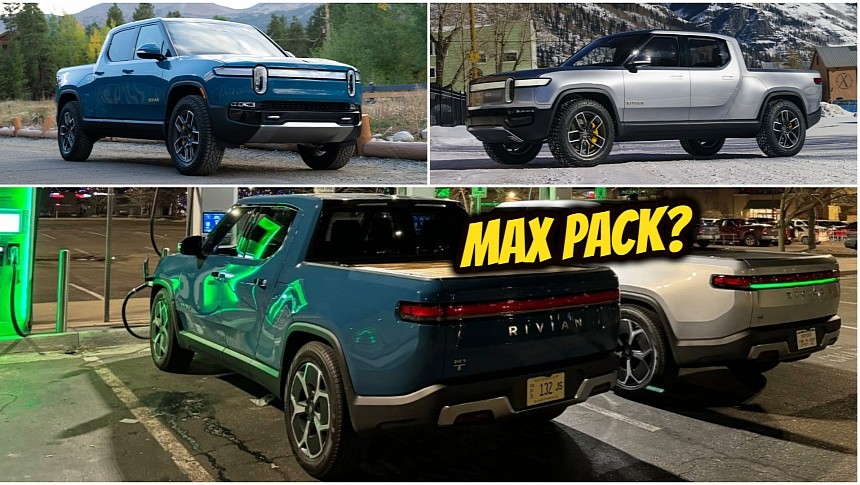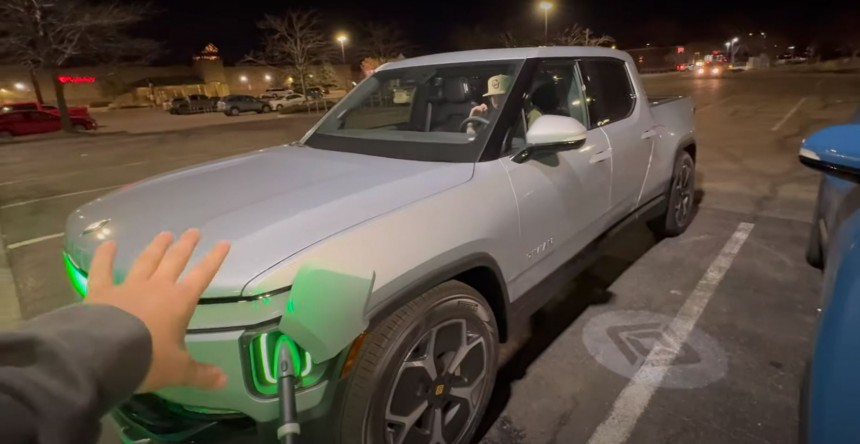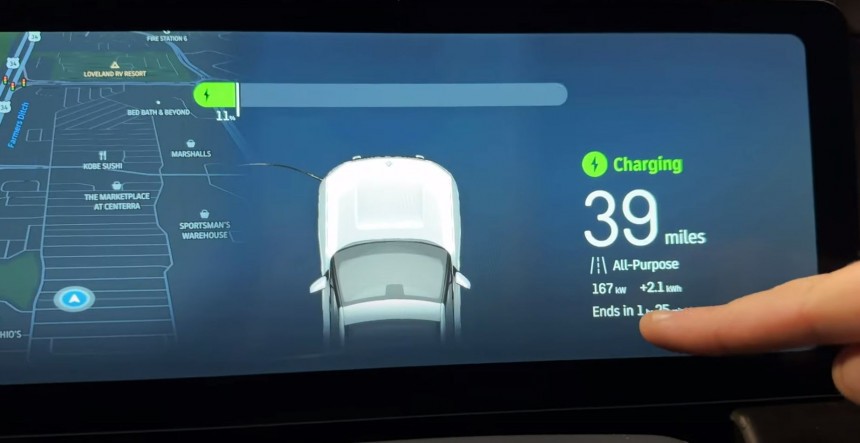Looking for a well-designed and capable all-electric pickup truck that won't take months to arrive in your driveway? When writing, there's no better option than the Rivian R1T. That's the truth. We're not playing favorites. But if you are going to spend your hard-earned money on an R1T, which version should you go for? There's a new test that might help you decide. Let's dive in.
Out of Spec Reviews put two dual-motor R1Ts riding on 21-inch wheels head-to-head in a not-so-common test comparison. Both EVs have the oil-cooled Enduro drive units Rivian developed in-house. The key difference is the high-voltage battery pack.
That brings us to the price. The dual-motor R1T equipped with the 135-kWh large-pack battery has a starting cost of $79,000. It should be able to go 352 miles on a single charge.
The same all-electric pickup truck boasting the 149-kWh max-pack high-voltage energy storage unit is $10,000 more expensive. It's also supposed to add 58 miles of EPA-rated range over what the large-pack battery can offer.
An extra $5,000 can unlock 132 horsepower and two more drive modes, no matter what battery option you go for. The vehicles in the video below do not have that option ticked.
Right from the get-go, replenishing from 10% reveals that the Rivian pickup truck with the largest battery can take full advantage of a capable DC fast charger by accepting its maximum output rate. The other R1T requested 400 amps instead of almost 500. It reached the peak after the charging level climbed to 15%.
So, the max-pack battery can charge a bit faster than the 135-kW energy storage unit. Keep in mind that the Rivian R1T's battery isn't built on the 800V architecture, so it can't charge at speeds of over 220 kW.
But as the batteries were nearing a 30% state of charge, the max pack started slowing down. It pulled electrons at a rate of 185 kW, while the large pack was charging at a speed of 215 kW.
That's why high-voltage batteries charge faster when the state of charge is low and take a long, long time to go above the 80% threshold, even if your EV is hooked to a DC dispenser.
After a quarter of an hour passed, the results showed that:
Surprisingly, the cheaper R1T performed better after the charging level increased. It added 2.4 kWh of extra energy.
The journey starts in all-purpose mode with the suspension set to the lowest height setting, the regenerative braking at its maximum level, and the A/C on auto. Dual-motor R1Ts can disengage the rear motor by themselves, essentially becoming front-wheel-drive vehicles when the computer figures out it doesn't have to put the pickup truck's assets to work.
The silver R1T (Large pack) had a tonneau cover, while the blue one (Max pack) didn't. So, they improvised to ensure that aerodynamics wouldn't impact the test results. The blue R1T received a tonneau cover of its own made from two pieces of plywood.
They also maintained a good distance from each other so nobody would benefit from an aero advantage.
Thus, the zero-emission vehicles performed almost similarly. There's no real advantage to having the max-pack R1T when the only thing that matters is fast charging and going from one point to another at highway speeds.
But it's important to remember that the two high-voltage energy storage units have an EPA-rated difference of 58 miles. When charged to 100%, the max-pack R1T could go farther than the large pack. That could come in handy if you live in a place where seasonal weather changes bring temperatures that oscillate between very hot and very cold.
The question that you must answer is the following: is spending an extra 10 bands for around 50 miles of real-world range worth it?
Don't forget that in about seven months, Rivian will debut a cheaper battery option known as the "standard" pack. That could be an even better choice if you're mostly an urban dweller.
That brings us to the price. The dual-motor R1T equipped with the 135-kWh large-pack battery has a starting cost of $79,000. It should be able to go 352 miles on a single charge.
The same all-electric pickup truck boasting the 149-kWh max-pack high-voltage energy storage unit is $10,000 more expensive. It's also supposed to add 58 miles of EPA-rated range over what the large-pack battery can offer.
An extra $5,000 can unlock 132 horsepower and two more drive modes, no matter what battery option you go for. The vehicles in the video below do not have that option ticked.
Figuring out what works
The test puts two R1Ts through an interesting verification process. They arrive at Electrify America stalls with 10% left in the "tank" and charge for 15 minutes. Then, they go for a drive on the highway with the intention of maintaining an average speed of 80 mph.Right from the get-go, replenishing from 10% reveals that the Rivian pickup truck with the largest battery can take full advantage of a capable DC fast charger by accepting its maximum output rate. The other R1T requested 400 amps instead of almost 500. It reached the peak after the charging level climbed to 15%.
So, the max-pack battery can charge a bit faster than the 135-kW energy storage unit. Keep in mind that the Rivian R1T's battery isn't built on the 800V architecture, so it can't charge at speeds of over 220 kW.
But as the batteries were nearing a 30% state of charge, the max pack started slowing down. It pulled electrons at a rate of 185 kW, while the large pack was charging at a speed of 215 kW.
Intriguing outcomes
If that is confusing, think about it like this: imagine you have to fill a stadium with tens of thousands of people. The first couple of thousands are easy to manage because they find their unoccupied seats easier. It only gets complicated afterward because more people are entering the premises and trying to find their assigned places.That's why high-voltage batteries charge faster when the state of charge is low and take a long, long time to go above the 80% threshold, even if your EV is hooked to a DC dispenser.
After a quarter of an hour passed, the results showed that:
- the large-pack-equipped R1T added 49.6 kWh;
- the max-pack-equipped R1T added 47.2 kWh.
Surprisingly, the cheaper R1T performed better after the charging level increased. It added 2.4 kWh of extra energy.
The journey starts in all-purpose mode with the suspension set to the lowest height setting, the regenerative braking at its maximum level, and the A/C on auto. Dual-motor R1Ts can disengage the rear motor by themselves, essentially becoming front-wheel-drive vehicles when the computer figures out it doesn't have to put the pickup truck's assets to work.
The silver R1T (Large pack) had a tonneau cover, while the blue one (Max pack) didn't. So, they improvised to ensure that aerodynamics wouldn't impact the test results. The blue R1T received a tonneau cover of its own made from two pieces of plywood.
An unexpected outcome
The silver R1T covered 85 miles and consumed 44 kWh (1.95 mi/kWh). The blue Rivian pickup truck drove 84.4 miles and used 43 kWh of energy (1.97 mi/kWh).Thus, the zero-emission vehicles performed almost similarly. There's no real advantage to having the max-pack R1T when the only thing that matters is fast charging and going from one point to another at highway speeds.
But it's important to remember that the two high-voltage energy storage units have an EPA-rated difference of 58 miles. When charged to 100%, the max-pack R1T could go farther than the large pack. That could come in handy if you live in a place where seasonal weather changes bring temperatures that oscillate between very hot and very cold.
The question that you must answer is the following: is spending an extra 10 bands for around 50 miles of real-world range worth it?
Don't forget that in about seven months, Rivian will debut a cheaper battery option known as the "standard" pack. That could be an even better choice if you're mostly an urban dweller.











